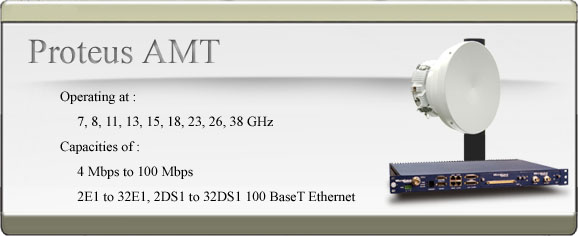 |



|
 |

|
 |
| Our Coordinates: Lat 42.75 N, Long 71.85 W |


 |
Proteus AMT

High Frequency PDH Digital Radios at 7, 8, 11, 13, 15, 18, 23, 26, & 38 GHz International data rates of 2 E1 to 32 E1 or 2 E3, Full 100 Mbps Fast Ethernet version Uses half the traditional bandwidth or allows double the capacity within the typical bandwidth Applications include: - PCS/PCN, Cellular networks
- Wireless Local Loop
- Last Mile Network Access
- Internet Access
- LMDS backhaul Download the Proteus Domestic data sheet - PDF Version Download the Proteus International data sheet - PDF Version
Proteus AMT is the newest member of Airlinx’ family of products. By dynamically changing the RF modulation from 4PSK to 32 QAM as required, Proteus AMT is ideal for areas where frequency spectrum is limited or for users who need expanded data capacity in existing bandwidth. The wide variety of user interfaces, including full 100 Mbps Fast Ethernet, makes Proteus AMT perfect for Cellular/PCS backhaul – especially those networks ready for the transition to 3G. The capability to mix PDH with packet data in the same radio terminal is a unique and very useful benefit for leveraging existing networks with the networks of tomorrow. As a result, this platform offers optimal flexibility and scalability to allow mobile operators the quick deployment and/or redeployment needed for generating immediate revenue.
Twice The Data
With adaptive modulation schemes up to 32 QAM the Proteus AMT can pack twice as much data into the same bandwidth compared to common 4-level modulation radios (QPSK or 4FSK). For example, Proteus AMT allows 12 E1s in 7 MHz or 32 E1s in 28 MHz. This feature is ideal for users who want to increase their data throughput without paying for more bandwidth.
Half The Bandwidth
The same adaptive modulation technology that allows a user to double his capacity can be used to transmit existing data using only half of the previous bandwidth. In many cases the narrower bandwidth means lower licensing fees.
Full 100BaseT Fast Ethernet
Proteus AMT provides a full 100 Mbps Ethernet throughput in 28 MHz bandwidth. As the available bandwidth decreases, the Ethernet throughput is scaled to match – up to 9 Mbps in 3.5 MHz.
Unmatched Data Flexibility
The capability to mix PDH with packet data in the same radio is a unique and very useful way to leverage existing networks with the networks of tomorrow. With Proteus AMT, one basic Indoor Unit is used across all frequency bands and accepts two separate plug-in modules. Both PDH modules up to 16E1’s or E3 and an IP module with a 4-port 10/100BaseT interface are available and can be used in any combination. This flexibility allows up to 32 E1s or 100 Mbps Ethernet, or a combination of up to 16E1’s with Ethernet.
Higher System Gain
Where bandwidth efficiency is not the primary concern Proteus AMT delivers unmatched system gain. Using lower level modulation techniques and advanced Trellis Coding, overall system gain can increase 2-4 dB over conventional microwave radio systems.
Configuration and SNMP Management
The fully software controlled Proteus AMT makes initialization and maintenance simple. Link setup is as easy as selecting the TX and RX frequencies and indicating the number of E1 channels to be used. Based on this information, Proteus AMT configures both the local and far-end terminals. Using standard SNMP-2 protocol and on-board routing, radio IP addresses can be quickly and efficiently set and controlled. A standard SNMP manager can be used from a central location to monitor and control the entire network, or the custom graphical interface can be used from any location to control any device within the network.
Applications
There is a Proteus radio solution perfect for any short haul application. A few of the many system solutions are listed below. Data and IP based solutions (100 Mbps) - ISP networks - Private Network LANs and WANs | Low Capacity (6 Mbps to 45 Mbps) Interconnect solutions - Cellular/GSM Interconnect - PCN/PCS Interconnect - Public Safety networks - Utilities (Oil, Gas, Electric, Railroad) - Competitive Local Exchange Carriers | High Capacity (45 Mbps to 65 Mbps) Infrastructure solutions - Cellular/GSM Infrastructure - PCN/PCS Infrastructure - Public Safety Ring Infrastructure - Utilities (Oil, Gas, Electric, Railroad) Backbone - Competitive Local Exchange Carriers | |
|
 |
|
Toll Free (888) 224-6814 | Fax (603) 878-0530 | E-mail
Copyright © 1997 - 2026 AIRLINX Communications, Inc. Powered by SpokenSkills
|
|
 |

